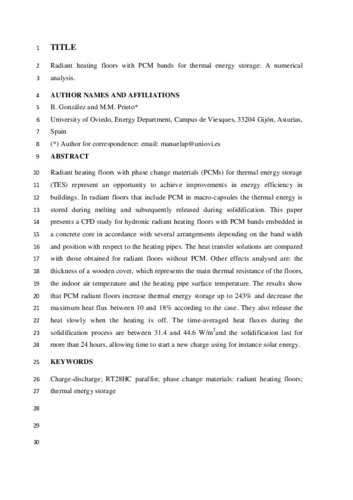Radiant heating floors with PCM bands for thermal energy storage: a numerical analysis
Autor(es) y otros:
Fecha de publicación:
Versión del editor:
Citación:
Resumen:
Radiant heating floors with phase change materials (PCMs) for thermal energy storage (TES) represent an opportunity to achieve improvements in energy efficiency in buildings. In radiant floors that include PCM in macro-capsules the thermal energy is stored during melting and subsequently released during solidification. This paper presents a CFD study for hydronic radiant heating floors with PCM bands embedded in a concrete core in accordance with several arrangements depending on the bandwidth and position with respect to the heating pipes. The heat transfer solutions are compared with those obtained for radiant floors without PCM. Other effects analysed are: the thickness of a wooden cover, which represents the main thermal resistance of the floors, the indoor air temperature and the heating pipe surface temperature. The results show that PCM radiant floors increase thermal energy storage up to 243% and decrease the maximum heat flux between 10 and 18% according to the case. They also ...
Radiant heating floors with phase change materials (PCMs) for thermal energy storage (TES) represent an opportunity to achieve improvements in energy efficiency in buildings. In radiant floors that include PCM in macro-capsules the thermal energy is stored during melting and subsequently released during solidification. This paper presents a CFD study for hydronic radiant heating floors with PCM bands embedded in a concrete core in accordance with several arrangements depending on the bandwidth and position with respect to the heating pipes. The heat transfer solutions are compared with those obtained for radiant floors without PCM. Other effects analysed are: the thickness of a wooden cover, which represents the main thermal resistance of the floors, the indoor air temperature and the heating pipe surface temperature. The results show that PCM radiant floors increase thermal energy storage up to 243% and decrease the maximum heat flux between 10 and 18% according to the case. They also release the heat slowly when the heating is off. The time-averaged heat fluxes during the solidification process are between 31.4 and 44.6 W/m2and the solidification last for more than 24 h, allowing time to start a new charge using for instance solar energy.
ISSN:
Patrocinado por:
We wish to express our gratitude to the University Institute of Industrial Technology of Asturias (IUTA), the Ph.D. programme in Energy and Processes Control, University of Oviedo, and Gijón City Council for financial support under project SV-17-GIJÓN-1-22, which made this research work possible.
Ficheros en el ítem





